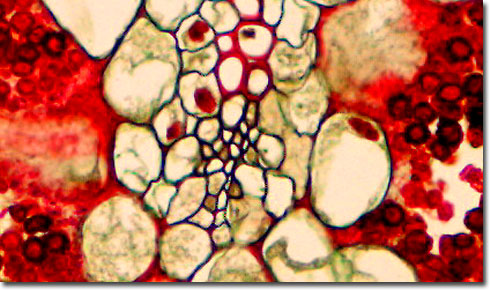Stained Onion Tissue
|
Onions come in many shapes, sizes, and cultivars including Bermuda, yellow, red, white, Texas sweets, pearls, and the often elusive and highly prized sweet Vidalia from southern Georgia. With relatives such as leeks, green onions, scallions, and the large family of garlic, dried or powdered onion just doesn't cut it. Infamous for the telltale signs on the gourmet's breath, onions not only provide flavor, they also contain important nutrients and disease-fighting phytochemicals. The flavinoid quercetin, an antioxidant (phytochemical) found in onions, helps eliminate free radicals in the body, inhibits low-density lipoprotein oxidation, protects and regenerates vitamin E, and helps to circumvent the harmful effects of heavy metal ions. Onions have always held a place in folklore and folk medicine, but only recently have biochemists revealed their anti-bacterial properties, particularly against Helicobacter pylori, the ulcer-forming microorganism. Also, the more pungent onions exhibit strong anti-platelet and blood thinning activities in human blood, potentially adding protection against arteriosclerosis, cardiovascular disease, stroke, and heart attack. Other phytochemicals discovered in onions include disulfides, trisulfides, cepaene, and vinyl dithiins, each blessed with a variety of health-functional properties, including demonstrated anti-cancer and anti-microbial activities. The phytochemicals alliin (tasteless and odorless) and allicin (responsible for the garlic odor) are excellent antibiotics. Alliin is transformed into allicin when the onion (or garlic) plant tissue is crushed, releasing the enzyme allinase. Similar to oranges, onions are a good source of vitamin C, potassium, dietary fiber, vitamin B6, and folic acid. They also contain calcium, iron, have a high protein quality, are low in sodium, and contain no fat. Maybe you should reconsider the "hold" on those onions and think instead about an after-dinner mint or some raw parsley. Early history of the onion is largely a mystery, but traces can be found in the archaeology of Central Asia, Iran, and Western Pakistan. Paleontologists believe that wild onions were a primary staple in man's prehistoric diet. Researchers agree that the onion has been in cultivation for more than 5,000 years and has long been valued because of easy storage, transportability, and convenience in cultivation. In ancient Egypt, onions were considered an object of worship, symbolizing eternity, and often accompanied the Pharaohs to their pyramid tombs. Onions are often found in early Egyptian paintings and hieroglyphics, and the aphrodisiacal properties of onions have been touted throughout the ancient cultures of the world. On a burger, the peeled bulb is usually eaten, while in soups and salads, the green tops are featured. It is the sulfuric (thiol) compounds found in onions that bring tears to our eyes. To reduce the problem with a "hot" onion, chill the onion and cut into the root end of the onion last. If you like them grilled or sautéed, even the nastiest of onions can be brought under control with a little butter, wine, and some heat. |
© 1995-2022 by Michael W. Davidson and The Florida State University. All Rights Reserved. No images, graphics, software, scripts, or applets may be reproduced or used in any manner without permission from the copyright holders. Use of this website means you agree to all of the Legal Terms and Conditions set forth by the owners.
This website is maintained by our
|
